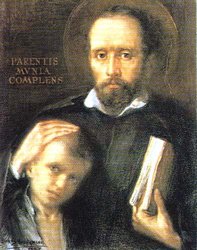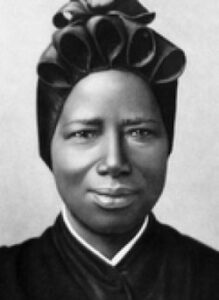Today we celebrate two special patron saints, St. Jerome Emiliani and St. Josephine Bakhita. Together these two saints are patrons of needy children. Today and every day, we celebrate the work that continues to uplift and protect the neediest, especially children.
Saint Jerome Emiliani

St. Jerome Emiliani was born in mid-fifteenth century Venice. The irreligious young man joined the army at 15 and was captured while on duty and chained in a dungeon. Jerome had a lot of time to think while in prison and had his conversion while imprisoned. He then escaped prison, and upon returning to Venice, took charge of the education of his nephews and began his own studies for priesthood.
A few years into his priesthood, plague and famine swept northern Italy. Fr. Jerome began caring for the sick and feeding the hungry, covering the cost of their needs. He decided to dedicate his life entirely to others, particularly to abandoned children. He founded three orphanages, a shelter for penitent prostitutes and a hospital.
A few years before his death, Fr. Jerome and two other priests established a congregation, the Clerks Regular of Somasca. Their order cared for dedicated to the care of orphans and the education of youth. St. Jerome died of a disease he caught while caring for the sick. Pope Pius Xl named him the patron of orphans and abandoned children.
St. Josephine Bakhita
 Josephine Bakhita was born in Olgossa in the Darfur region of southern Sudan. When she was about 8, Josephine was kidnapped, sold into slavery and given the name Bakhita, which means fortunate. She was resold several times, finally in 1883 to Callisto Legnani, an Italian consul in Khartoum, Sudan.
Josephine Bakhita was born in Olgossa in the Darfur region of southern Sudan. When she was about 8, Josephine was kidnapped, sold into slavery and given the name Bakhita, which means fortunate. She was resold several times, finally in 1883 to Callisto Legnani, an Italian consul in Khartoum, Sudan.
Two years later, he took Josephine to Italy and gave her to his friend Augusto Michieli. Bakhita babysat Mimmina Michieli, whom she accompanied to Venice’s Institute of the Catechumens, run by the Canossian Sisters. While Mimmina was being instructed, Josephine felt drawn to the Catholic Church. She was baptized and confirmed in 1890, and chose Josephine as her name.
When the Michielis returned from Africa and wanted to take Mimmina and Josephine back with them, the future saint refused to go. During the ensuing court case, the Canossian Sisters and the patriarch of Venice intervened on Josephine’s behalf. The judge concluded that since slavery was illegal in Italy, she had actually been free since 1885.
Josephine entered the Institute of St. Magdalene of Canossa in 1893 and made her profession three years later. A few years later, she was transfered to Schio, where she assisted her religious community through cooking, sewing, embroidery, and welcoming visitors at the door. During her 42 years there, she was dearly loved by the school children and the local people. When speaking of her enslavement, she often professed she would thank her kidnappers. For had she not been kidnapped, she might never have come to know Jesus Christ and entered His Church.
In her later years, she began to suffer physical pain and was forced to use a wheelchair. But she always remained cheerful. If anyone asked her how she was, she would reply, “As the master desires.” She was beatified in 1992 and canonized eight years later.
